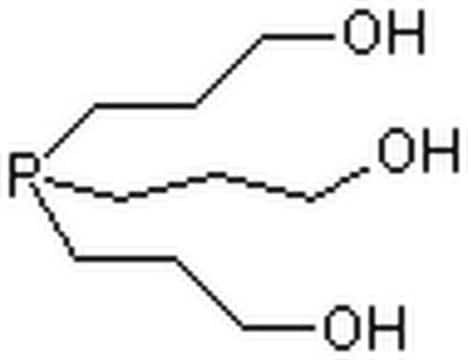68957
Tris(2-carbossietil)fosfina
BioUltra, suitable for electrophoresis, SDS-PAGE tested
Sinonimo/i:
TCEP
About This Item
Prodotti consigliati
Nome Commerciale
BioUltra
Saggio
97.5-102.5%
Forma fisica
powder
tecniche
electrophoresis: suitable
Solubilità
H2O: soluble
Compatibilità
SDS-PAGE tested
Stringa SMILE
Cl[H].OC(=O)CCP(CCC(O)=O)CCC(O)=O
InChI
1S/C9H15O6P.ClH/c10-7(11)1-4-16(5-2-8(12)13)6-3-9(14)15;/h1-6H2,(H,10,11)(H,12,13)(H,14,15);1H
PBVAJRFEEOIAGW-UHFFFAOYSA-N
Cerchi prodotti simili? Visita Guida al confronto tra prodotti
Categorie correlate
Descrizione generale
Applicazioni
Caratteristiche e vantaggi
- TCEP.HCL lowers reactive oxygen species levels.
- It increases glutathione levels and mitochondrial content.
- It has anti-cancer effects.
Risultati analitici
Avvertenze
Danger
Indicazioni di pericolo
Classi di pericolo
Eye Dam. 1 - Skin Corr. 1B
Codice della classe di stoccaggio
8A - Combustible corrosive hazardous materials
Classe di pericolosità dell'acqua (WGK)
WGK 1
Certificati d'analisi (COA)
Cerca il Certificati d'analisi (COA) digitando il numero di lotto/batch corrispondente. I numeri di lotto o di batch sono stampati sull'etichetta dei prodotti dopo la parola ‘Lotto’ o ‘Batch’.
Possiedi già questo prodotto?
I documenti relativi ai prodotti acquistati recentemente sono disponibili nell’Archivio dei documenti.
I clienti hanno visto anche
Articoli
Workflows for monoclonal antibody adalimumab characterization ensure drug safety and efficacy through critical quality attribute analysis.
Protocolli
SEC-MS protocol for rapid glycoprofiling of monoclonal antibodies with antibody purification and mass spectrometer calibration.
A complete workflow for the intact and middle-up mass analysis of reduced and non-reduced monoclonal antibodies based on SEC-MS with sample preparation by protein-A affinity clean-up.
Il team dei nostri ricercatori vanta grande esperienza in tutte le aree della ricerca quali Life Science, scienza dei materiali, sintesi chimica, cromatografia, discipline analitiche, ecc..
Contatta l'Assistenza Tecnica.









